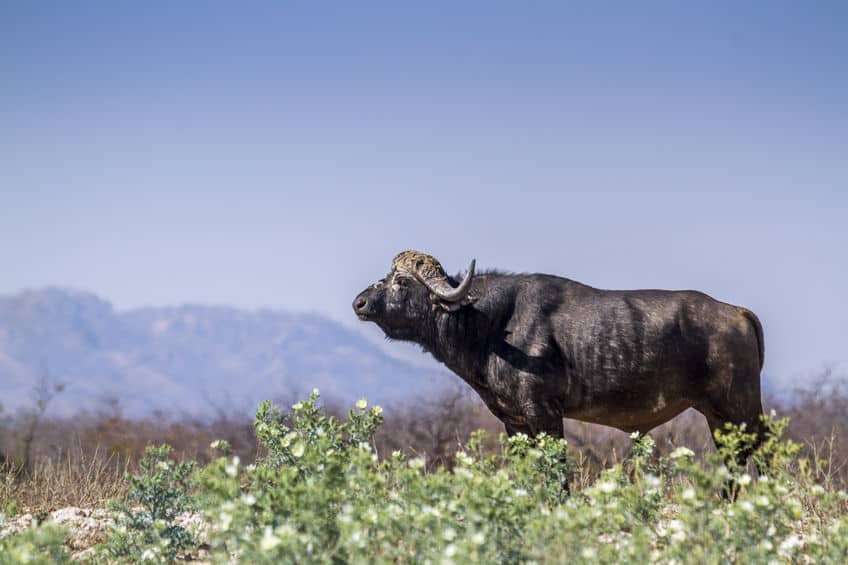
Cape buffalos, or African buffalos, are very large and incredibly strong animals that can be extremely dangerous. They are beautiful and mesmerizing creatures in many ways and there are numerous fascinating facts about them.
Below, you can find 50 interesting, captivating, fun, or even strange facts about Cape buffalos.
General Cape Buffalo Facts
- Cape buffalos belong to the Bovidae family of animals.
- A male Cape buffalo is called a bull and a female is called a cow.
- Cape buffalos are herbivores and their diet consists almost entirely of grass.
- Cape buffalos are known for being unpredictable and aggressive.
- Cape buffalos are often referred to as Black Death or Widowmakers.
Cape Buffalo Appearance And Anatomy
- Male Cape buffalos weigh 1100-2000 pounds (500-900 kg) and females weigh 770-1365 pounds (350-620 kg).
- Cape buffalos can be up to 5.7 ft (175 cm) tall.
- Cape buffalos can run 35 mph (57 kph).
- Male Cape buffalos are slightly darker than females.
- A darker color is associated with dominance for male Cape buffalos.
- Male Cape buffalos spend large amounts of time rolling around in the mud to become darker.
- Male Cape buffalos have thicker necks and shoulders than females.
- Male Cape buffalos have thicker horns than females.
- Female Cape buffalos have longer horns than males.
- The largest Cape buffalo horn ever on record measured 64 inches (163 cm). This record belongs to a female.
- Male Cape buffalos’ horns meet in the middle and form a rock-hard and thick area called a boss.
- The boss on a male Cape buffalo is so thick that it can stop bullets.
Cape Buffalo Distribution And Habitat
- Cape buffalos can be found all over sub-Saharan Africa.
- Cape buffalos can live in many types of habitats and are mostly found in savanna, wetlands, shrubland, grassland, forest, and desert.
Cape Buffalo Conservation
- The conservation status of Cape buffalos is Near threatened.
- There are 398,000 to 401,000 Cape buffalos left in the wild in Africa according to IUCN.
Cape Buffalo Life Cycle
- Cape buffalos have a lifespan of 22 years in the wild but a life expectancy of just 11 years. They have a lifespan of 29 years in captivity.
- Cape buffalos reach sexual maturity around the age of 3 to 5 years.
- The gestation period for female Cape buffalos is 11-11.5 months.
- Female Cape buffalos give birth to 1 calf at a time.
- Cape buffalo calves weigh 66 to 132 lb (30 to 60 kg) at birth.
- Female Cape buffalos raise the calves. The males generally do not invest time or energy in the calves.
- Sometimes female Cape buffalos can adopt calves that have lost their mother.
Cape Buffalo Social Structure
- Cape buffalos are highly social creatures that usually stay together in groups of 15-20.
- A group of Cape buffalos is called a herd.
- A herd of Cape buffalos consists of a large group of females that are related to each other, their calves, and a smaller group of males.
- The female Cape buffalos in a herd decide which way the herd moves.
- Male Cape buffalos fight each other to establish dominance in the herd.
- The dominant male Cape buffalo will be more attractive to the females.
- Cape buffalo herds can have up to 3000 members. These herds are temporary and mostly occur during mating season and for long walks.
- Male Cape buffalos that are too old to produce offspring sometimes leave their herd and live on their own or form small male herds with other old bulls.
Cape Buffalo And Natural Enemies
- Lions are the most common natural enemies for Cape buffalos.
- Cape buffalos are so strong that they can use their horns to throw a lion several meters through the air.
- Cape buffalos are great at defending each other and will come and help if a member of their herd is under attack by a predator. When one Cape buffalo attacks, the rest will usually follow.
- Cape buffalos can use their horns to impale enemies.
- In some regions of Africa, Cape buffalos make up the majority of lions’ food.
- Cape buffalos have been observed systematically seeking out and killing lion cubs.
- Fully grown Cape buffalos have thick and dense ribs that almost work like armor that protects the chest and organs.
- The most common cause of death in Cape buffalos is disease. Cape buffalos live in dense herds so diseases can spread rapidly.
Cape Buffalo And Humans
- It is estimated that Cape buffalos are responsible for around 200 human deaths per year.
- Cape buffalos are thought to have killed more big-game hunters than any other African mammal.
- Cape buffalos are considered to be the most dangerous of the big five.
- If a hunter escapes an attacking Cape buffalo by climbing up into a tree, the Cape buffalo can wait underneath the tree for several hours to get revenge.
- Cape buffalos can sneak around a hunter and charge from behind.
- Cape buffalos do not mock charge. Once they charge, they will try to kill their target.
If you find Cape buffalos interesting and you want to learn more about them, I recommend heading over to this page where you can find all our posts about Cape buffalos.
